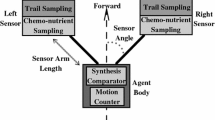Abstract
The slime mold Physarum polycephalum is renowned for its incredible perceived intelligence despite it being a unicellular organism devoid of a central nervous system. Some notable abilities of the true slime mold include exploring an area for food sources and establishing energy-efficient networks between them. The network progression of the slime mold can be quantified as entropy of the system in combination with the nearest-neighbor distance of each plasmodium; specifically, as the network progresses we expect the entropy and average nearest-neighbor distance to decrease. The mold and its plasmodium explore an area using chemotaxis to move toward a higher concentration of a chemical stimulus within an extracellular chemical gradient. The slime mold’s chemotaxis behavior has been modeled using electrical networks, gradient fields, and nodal graphs. We leverage the use of a gradient field model to instruct individual agents, realized using simulated and real-world robots, within a multi-agent swarm to emulate the slime mold’s exploratory and network establishing behaviors. Beginning with a holonomic simulation and ending with a non-holonomic deployable protocol, the system’s entropy and distance to the nearest neighbor are compared between the two implementations. We demonstrate the efficacy of this model for use in multi-agent swarms, highlighting its ability to autonomously discover food sources (targets) while also establishing a network between them.










Similar content being viewed by others
References
Yokoi H, Mizuno T, Takita M, & Kakazu, Y (1996). Amoeba like grouping behavior for autonomous robots using vibrating potential field (obstacle avoidance on uneven road). In: Distributed Autonomous Robotic Systems 2, pages 209–220. Springer
Jones JD (215) Exploiting environmental computation in a multi-agent model of slime mould. In: AIP Conference Proceedings
Bin Y, Yongsheng D, Yaochu J, Kuangrong H (2015) Self-organized swarm robot for target search and trapping inspired by bacterial chemotaxis. Rob Auton Syst 72:83–92
Trianni V, Nolfi S, Dorigo M (2008) Evolution, self-organization and swarm robotics. In: Swarm Intelligence, pages 163–191. Springer
Nakagaki T et al (2004) Obtaining multiple separate food sources: behavioural intelligence in the physarum plasmodium. Proc Biol Sci 271:2305–2310
Becker R, Bonifaci V, Karrenbauer A, Kolev P, Mehlhorn K (2019) Two results on slime mold computations. Theo Comput Sci 773:79–106
Adamatzky A, Schubert T (2014) Slime mold microfluidic logical gates. Mater Today 17:86–91
Li K, Torres CE, Thomas K, Rossi LF, Shen C-C (2011) Slime mold inspired routing protocols for wireless sensor networks. Swarm Intell
Jeff J (2010) Characteristics of pattern formation and evolution in approximations of physarum transport networks. Artif life 16(2):127–153
Jones J (2001) Influences on the formation and evolution of physarum polycephalum inspired emergent transport networks. Nat Comput
Jeff J (2015) Mechanisms inducing parallel computation in a model of physarum polycephalum transport networks. Parallel Process Lett 25(01):1540004
Stock JB, Baker MD (2009) Chemotaxis. Encyclopedia of Microbiology. Elsevier Inc., Amsterdam, pp 71–78
Frédéric D (2003) Army ants trapped by their evolutionary history. PLoS Biol 1(2):e37
Khan LU (2017) Visible light communication: Applications, architecture, standardization and research challenges. Digit Commun Netw
Cai Y et al. (2017) Indoor high precision three-dimensional positioning system based on visible light communication using particle swarm optimization. IEEE Photon J
Author information
Authors and Affiliations
Corresponding author
Additional information
Publisher's Note
Springer Nature remains neutral with regard to jurisdictional claims in published maps and institutional affiliations.
This work was presented in part at the joint symposium of the 27th International Symposium on Artificial Life and Robotics, the 7th International Symposium on BioComplexity, and the 5th International Symposium on Swarm Behavior and Bio-Inspired Robotics (Online, January 25-27, 2022).
About this article
Cite this article
Chance, H.R., Lofaro, D.M. & Sofge, D. An implementation of a Physarum polycephalum model on a swarm of non-holonomic robots. Artif Life Robotics 27, 663–673 (2022). https://doi.org/10.1007/s10015-022-00806-2
Received:
Accepted:
Published:
Issue Date:
DOI: https://doi.org/10.1007/s10015-022-00806-2




